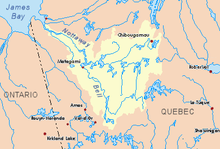| Saint-Cyr | |
|---|---|
 Watershed of Nottaway River | |
| Location | |
| Country | Canada |
| Province | Quebec |
| Region | Nord-du-Québec |
| Physical characteristics | |
| Source | Barry Lake (Saint-Cyr River South) |
| • location | Eeyou Istchee James Bay (municipality), Nord-du-Québec, Quebec |
| • coordinates | 49°00′31″N 75°34′23″W / 49.00861°N 75.57306°W |
| • elevation | 395 m (1,296 ft) |
| Mouth | Mégiscane River |
• location | Eeyou Istchee James Bay (municipality), Nord-du-Québec, Quebec |
• coordinates | 49°19′12″N 75°18′42″W / 49.32000°N 75.31167°W |
• elevation | 338 m (1,109 ft) |
| Length | 48.9 km (30.4 mi)[1] |
| Basin features | |
| Tributaries | |
| • right | Doda Lake |
The Saint-Cyr River /ˌseɪntˈsɪər/ is a tributary of Doda Lake, flowing into the municipality of Eeyou Istchee Baie-James (municipality), in Jamésie, in the area of Nord-du-Québec, Quebec, Canada.
The Saint-Cyr river flows successively into the townships of Urban, Lacroix, Belmont and Royal. Forestry is the main economic activity of the sector; recreational tourism activities, second.
The Saint-Cyr River valley is served by the forest road R1053 (east-west direction) which passes on the north-west side and north of Lac Saint-Cyr. This road joins the road R1009 (North-South direction) which passes to the East of the Aigle River (Doda Lake).
The surface of the Saint-Cyr River is usually frozen from early November to mid-May, however, safe ice circulation is generally from mid-November to mid-April.
- ^ "Atlas of Canada". atlas.nrcan.gc.ca. Retrieved 2018-01-21.